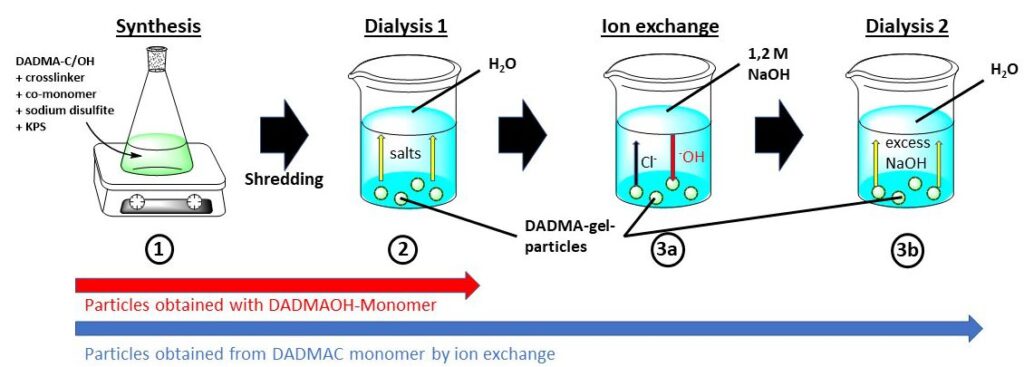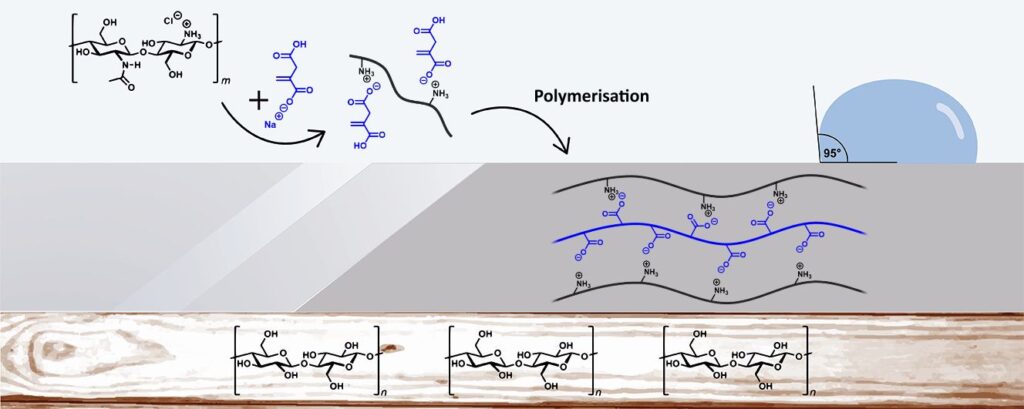Kategorie: ‘Publication’
Contributions to our publication:
Fire-retardant wood coating
The publication “Fire-retardant Coating For Wood Made From Chitosan Itaconate” is internationally recognised by an article in the Italian trade journal Pitture e Vernici – European Coatings (Issue 1/2025, page 36) and by a web post by European Coatings entitled “A fire-retardant coating for wood made from chitosan itaconate” – News and insights for the European coatings industry. The chitosan itaconate glaze is transparent, emphasises the natural wood grain and renders the surface water-repellent. It reliably protects the wood from moisture, prevents UV-induced greying and efficiently reduces the burning rate. With just two applications on spruce and three on beech wood, the glaze is self-extinguishing. Find out more.
This bio-based approach combines resource conservation with effectiveness and demonstrates how environmental preservation and safety requirements can be successfully combined. It fills us with joy and appreciation to see that our work is attracting greater attention.
Pitture E Vernici: Fire-retardant Coating For Wood Made From Chitosan Itaconate, Fascicolo 1/Gennaio – Febbraio 2025 – Pitture e Vernici, https://www.pittureevernici.it/archivio/archivio-2025/fascicolo-1-gennaio-febbraio2025/.
European Coatings: A fire-retardant coating for wood made from chitosan itaconate – News and insights for the European coatings industry, https://www.european-coatings.com/news/application-areas/a-fire-retardant-coating-for-wood-made-from-chitosan-itaconate/.
Joint publication:
Plant protection from insect larvae

The black soldier fly (Hermetia illucens) not only offers a sustainable source of protein, but also the potential to extract chitosan – a versatile biopolymer – from the larval skins. A joint study with the research group led by Dr. Sabine Gruber from the University of Innsbruck and the FH Campus Vienna shows how biological waste from BSF production can be processed into bioactive chitosan using environmentally friendly enzymatic processes. This chitosan has strong antifungal properties and improves the germination and disease resistance of plants such as sugar beet. It therefore offers an environmentally friendly alternative to chemical fungicides and chitosan, which is obtained from crescent shells. This innovation underlines the potential of the insect industry to make good use of waste and create sustainable solutions for agriculture and industry.
C. Escobar Rodríguez, V. Zaremska, T. Klammsteiner, I. Kampatsikas, N. Münstermann, O. Weichold, S. Gruber
Chitosan obtained from black soldier fly larval cuticles expands the value chain and is effective as a biocontrol agent to combat plant pathogens
Carbohydrate Polym. 2025, 349, Part B, 123023 https://doi.org/10.1016/j.carbpol.2024.123023
New publication:
Fire-retardant wood coating

Wood is currently experiencing a renaissance in the construction and furniture industry. With its natural charm, versatility and environmental friendliness, wood is a popular building material. However, this natural material is susceptible to external influences such as moisture, UV radiation, stains and, above all, fire. Fire in particular poses a major risk in the construction industry due to the easy flammability of wood. Once ignited, untreated wood often burns down completely without any external heat supply. N. Münstermann and O. Weichold have now developed an innovative, sustainable wood coating based on polymerized chitosanitaconate. The basis of the coating, chitosan, is a residual product from the food industry and itaconic acid can be obtained biotechnologically. The coating is therefore made entirely from bio-based materials and not only offers protection against moisture, UV radiation and stains, but is also non-flammable. When applied to wood, it delays ignition and significantly inhibits the spread of flames. Just one coat reduces the burning rate by a third. Two coats on spruce wood are enough to make the material self-extinguishing. Three layers are required for hardwoods such as beech. This bio-based approach combines resource conservation with high effectiveness and shows that environmental protection and safety requirements can go hand in hand.
N. Münstermann, O. Weichold
A fire-retardant coating for wood made from chitosan itaconate
Progress in Organic Coatings 2024, 197, 108793 https://doi.org/10.1016/j.porgcoat.2024.108793
New publication:
Approaches to upscaling alkaline gels as particles

Highly alkaline hydrogels are becoming increasingly important in building materials research. We have been able to show repeatedly that cationic alkaline hydrogels based on diallyldimethylammonium hydroxide (DADMAOH) in particular can be used effectively to seal water-bearing cracks or as coupling media for electrochemical chloride extraction. Upscaling is a challenge, as commercial cation-selective membranes have proven to be less effective here. On the other hand, neutral gels and gel particles can be easily prepared from diallyldimethylammonium chloride (DADMAC) in large quantities and with a wide range of compositions. Here it is shown that these neutral gel particles can be converted into DADMAOH particles with residual halide contents of <0.3 % by means of inverse static anion exchange in NaOH solution. The physical and chemical properties of the alkaline particles correspond to those of the alkaline gels and fulfill all necessary requirements for building material applications, but are much easier to produce.
T. B. Mrohs, O.Weichold
A Simple Preparation of Crosslinked, Highly Alkaline Diallyldimethylammonium Hydroxide Hydrogel Particles via Inverse Static Anion Exchange
Gels 2024, 10, 743. https://doi.org/10.3390/gels10110743 (open access)
17th ICPIC conference papers reprinted
The articles on the presentations “Ionic Conductive Polyesters-Assessing the Risk of Corrosion in Steel-Reinforced Concrete” by Prof. Weichold and “Alkaline Hydrogels-Multifunctional Materials for Concrete Rehabilitation” by Tim Mrohs (see also entry from 19.9.2023) at the 17th International Congress on Polymer in Concrete (ICPIC 2023) in Warsaw, Poland, have now been published in print.
Weichold, O. (2025). Ionic Conductive Polyesters—Assessing the Risk of Corrosion in Steel-Reinforced Concrete. In: Czarnecki, L., Garbacz, A., Wang, R., Frigione, M., Aguiar, J.B. (eds) Concrete-Polymer Composites in Circular Economy. ICPIC 2023. Springer Proceedings in Materials, vol 61. Springer, Cham. https://doi.org/10.1007/978-3-031-72955-3_34
Mrohs, T., Jung, A., Weichold, O. (2025). Alkaline Hydrogels—Multifunctional Materials for Concrete Rehabilitation. In: Czarnecki, L., Garbacz, A., Wang, R., Frigione, M., Aguiar, J.B. (eds) Concrete-Polymer Composites in Circular Economy. ICPIC 2023. Springer Proceedings in Materials, vol 61. Springer, Cham. https://doi.org/10.1007/978-3-031-72955-3_37
New publication:
Wood coating made from biogenic residues

Wood has been a central building material for mankind for thousands of years and is characterised by its bioavailability, sustainability and versatility. Nevertheless, the chemical structure of wood poses a number of challenges. It is susceptible to biological degradation processes, for example by fungi, bacteria or insects, and shows signs of graying due to lignin degradation when exposed to UV radiation. To prevent this, N. Münstermann and O. Weichold have developed an environmentally friendly coating based on chitosan, a biopolymer obtained from food waste.
The newly developed chitosanitaconate coating is transparent, emphasizes the wood grain and gives the wood hydrophobic properties with contact angles of over 90°. It effectively protects the wood from moisture, prevents graying caused by UV radiation and reduces staining caused by coffee or red wine, for example. Thanks to its strong adhesion and adaptability, the coating is highly versatile. By adding pigments, the coating can be adapted to the aesthetic requirements of modern interior design. Chitosanitaconate combines wood protection, modern aesthetics and sustainability – a versatile solution for environmentally friendly construction.
N. Münstermann, O. Weichold
Chitosan itaconate based water- and stain-repellent coatings for wood
Progress in Organic Coatings 2024, 194, 108630 https://doi.org/10.1016/j.porgcoat.2024.108630
Joint publication:
Metal complexes with keratin ligands
In collaboration with the research group led by Prof Panwad Sillapawattana from Maejo University, Chiang Mai, Thailand, complexes of Fe3+, Cu2+, Zn2+ and Ag+ with keratin ligands were produced and possibilities for application in the biomedical field were investigated. In particular, keratin hydrolysates with low molecular weight show higher metal adsorption. The overall results suggest that the specific properties of the complexes, including heat resistance, antibacterial activity and low cytotoxicity, are desirable for medical textiles.
A. K. Aldred, P. Klungsupya, W. Charerntantanakul, O. Weichold, P. Sillapawattana
Preparation of Keratin‑Metal Complexes Derived from Different Treatments of Chicken Feather Waste
Waste Biomass Valor. 2024, 15, 115. https://doi.org/10.1007/s12649-023-02154-z
New publication:
Resistance of crosslinkers in alkaline hydrogels

As part of our work on highly alkaline diallyldimethylammonium hydroxide (DADMAOH) hydrogels for the repair of mineral building materials, T. Mrohs and O. Weichold analysed the resistance of the four crosslinkers shown above. Classic amides such as N,N′-methylenebisacrylamide (BIS) decompose by slow hydrolysis, which leads to liquefaction of the gels. N,N,N′,N′-tetraallylpiperazinium dibromide (1b) decomposes surprisingly quickly due to chemical instabilities. In contrast, hydrogels with tetraallylammonium bromide (1a) or N,N,N′,N′,N′-tetraallyltrimethylene dipiperidinedibromide (1c) show no traces of degradation products even after 28 days at 60 °C. This corresponds to a shelf life of over 15 months at room temperature – sufficient for applications such as realkalisation or chloride extraction. These results show that such innovative materials are ideal for long-lasting construction applications.
T. B. Mrohs, O. Weichold
Hydrolytic Stability of Crosslinked, Highly Alkaline Diallyldimethylammonium Hydroxide Hydrogels
Gels 2022, 8, 669. https://doi.org/10.3390/gels8100669
New publication:
Gels as multifunctional repair materials
Alkaline hydrogels based on diallyldimethylammonium hydroxide (DADMAOH) can fulfil 3 important functions of repair materials for cracked concrete: Sealing of the crack to prevent water leakage, re-alkalisation of carbonated cement paste, which restores the alkali buffer, and re-passivation of steel reinforcement, which prevents corrosion of the reinforcement. In a proof-of-concept experiment, for example, the sealing properties of the gel were successfully tested on a cracked test specimen, where no leakage was observed under a water pressure of 5 metres for 28 days (WTA test W2.1-E).
A. Jung, O. Weichold
A 3-in-1 alkaline gel for the crack injection in cement-based materials with simultaneous corrosion protection and re-passivation of crack-crossing steel rebars
Construction Building Mater. 2022, 344, 128092. https://doi.org/10.1016/j.conbuildmat.2022.128092
New publication
New crosslinkers for diallylammonium gels
N,N’-methylene bisacrylamide (BIS) is a very popular crosslinker for radical polymerisation in water. It is highly reactive but tends to undergo alkaline hydrolysis and suffers from low solubility. This study shows that BIS forms only inhomogeneous networks with slowly polymerising systems such as N,N-diallyldimethylammonium chloride (DADMAC). As a result, gels with very low cross-linking densities, i.e. high swelling capacities, disintegrate during the swelling test. Coherent, i.e. highly cross-linked gels are not accessible due to the solubility limit. A promising alternative are multivalent tetraallyl compounds, such as tetraallylammonium bromide, N,N,N‘,N’-tetraallylpiperazinium dibromide and N,N,N‘,N’-tetraallyltrimethylenedipiperidinedibromide. In contrast to BIS, the copolymerisation with DADMAC is statistic. However, gelation with the new tetraallyl crosslinkers is much slower than with BIS and follows the order TAPB < TAMPB < TAAB, but the differences become significantly smaller as the content increases. At low contents, all three enable the production of gels with high swelling capacities of up to 360 g/g.
T. B. Mrohs, O.Weichold
Multivalent Allylammonium-Based Cross-Linkers for the Synthesis of Homogeneous, Highly Swelling Diallyldimethylammonium Chloride Hydrogels
Gels 2022, 8, 100. https://doi.org/10.3390/gels8020100



